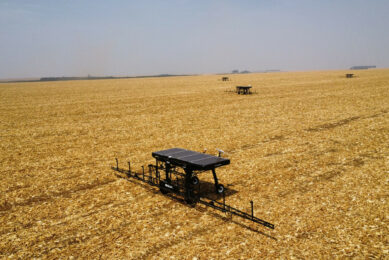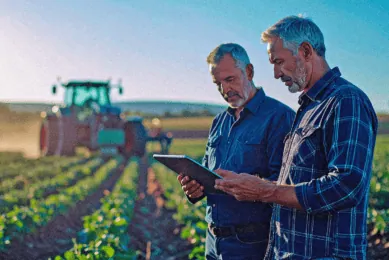Simply reducing spraying against botrytis is not possible, even with precision techniques

Can drones and AI better combat the fungal pathogen botrytis? “Yes, we are making progress,” says Dutch participant and bulb grower Henk Verdegaal of the National Fieldlab for Precision Farming (NPPL). And “no, it certainly hasn’t been a matter of plug & play in recent years. Everyone wants to, but the reality is much more challenging than often thought.”
NPPL participant Henk Verdegaal (51) grows 25 hectares of hyacinths in the Netherlands. He believes that pesticide use should be reduced to maintain sufficient societal support for the bulb sector. But he notes that it’s not so easy. He encounters the same obstacles that led to the establishment of the NPPL six years ago: while much seems possible in theory, it often isn’t in practice. Precision equipment and applications aren’t all they’re cracked up to be.
A press release some months ago: ‘Researchers from Dutch organizations Unmanned Valley, Greenport Duin- en Bollenstreek, and NL Space Campus have succeeded in developing an AI model that allows drones to recognize botrytis. The model uses artificial intelligence to analyze large amounts of drone data. The result is a clear map showing precisely which plants are diseased or at risk. This could significantly reduce the use of crop protection products.’
Text continues below picture

Not yet a working model
“Yes,” says bulb grower Henk Verdegaal, “that sounds promising and maybe it is. At least, I can see a development in the future where we achieve good disease prevention with fewer resources or better prevention with the same amount of resources. But we’re far from there yet. The tone of the final report seems overly positive to me. Video recordings were made here yesterday as well. Again, you get the impression that people think a working model has already been delivered for the recognition and improved management of botrytis.”
“That’s not the case. Maybe we can do something with it in the future, but first, we need to see if we can follow up on this. Right now, I can’t do much with it. It’s good to be clear about that.” Verdegaal was one of the two participants who had aerial photographs of hyacinth fields taken for the Remote Sensing project. The other participants’ fields were within the no-fly zone of the airport Schiphol.
Precision spraying against ‘fire blight’
In short, the project aims to map the degree of botrytis infestation (fire blight) and then tackle the fungus with a modified amount of pesticide. Precision spraying, so to speak. Again, from the press release: By detecting early and accurately when conditions require protection, these products can be applied very precisely, significantly reducing their use. Verdegaal has several reasons to temper the jubilant tone of the press release.
Text continues below picture

Tempering enthousiasm
Firstly, there is no reliable algorithm yet that recognizes botrytis. “For a reliable system, you need to annotate botrytis infestation on at least a thousand photos. I also worked on that; it takes hours per photo to do it properly. Very difficult, especially if the photos also show hail damage. In the project, we haven’t even reached a thousand photos yet. So, there isn’t a truly reliable model yet.”
However, good photos were taken last year. 2023 was quite a botrytis year. Many growers tried to prevent the disease with plant strengtheners and green products, but this often backfired. Even growers who fought botrytis in the conventional way often had disastrous situations. The moist conditions were ideal for the fungus. So, there was relatively much infestation, plenty of botrytis in the photos. However, once botrytis is visible in a crop, it’s already too late.
There are hardly any curative measures against fire blight, which is why growers mainly use preventive products. Verdegaal: “And the few products that have some curative effect are on the verge of disappearing. There is a start to a model, protocols, and infrastructure for the images, but it’s far from working yet.”
Text continues below picture

Going down the path of fewer resources
Henk Verdegaal finds it too early for much enthusiasm about the outcomes of the Remote Sensing project. But he is aware that he must continue down the path of reducing the use of synthetic/chemical products. It’s necessary to maintain sufficient societal support; to retain the license to produce. So, the search must continue, he believes.
“Perhaps the system can be further refined. If, at some point, artificial recognition becomes so good that an infestation can be detected in a very early stage, earlier than the human eye can, then perhaps Decision Support Systems (DSS) can be sharpened. I definitely have the desire to pursue this further. To investigate if that’s possible.”
Join 17,000+ subscribers
Subscribe to our newsletter to stay updated about all the need-to-know content in the agricultural sector, two times a week.



